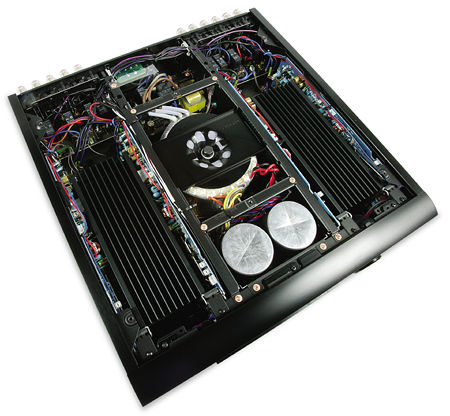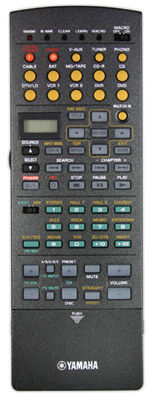Yamaha RX-Z9 AV receiver Page 2
Better yet, this receiver can upconvert and output component video to 480p (for progressive NTSC), 576p (PAL), 720p, or 1080i—with one significant limitation. Unlike some outboard video processors (such as the DVDO iScan HD, also reviewed in this issue), it will only convert copy-protected DVDs—which includes nearly all commercial releases—from 480i to 480p. It will not scale them up to 720p or 1080i.
Using video processing, including Faroudja DCDi, the Yamaha lets you select preset picture controls, adjust the sharpness (Enhancer) in 24 steps, apply video noise reduction in 10 steps, and fiddle with Brightness, Contrast, and Saturation. That's the good news.

The bad news is that these adjustments are made at the system level; you can't make individual settings for each input. So any image correction you want to apply to your cable box will be applied to your progressive DVD player as well. One size, unfortunately, does not fit all.
Impressive Impressions
The Yamaha RX-Z9's phono section was detailed, warm, and capable of better resolution than either of my two relatively inexpensive standalone phono preamps. Listening to "Roosevelt and Ira Lee," from King Harvest's famous Dancing in the Moonlight (LP, Perception PLP 36), the hard-right Hammond B3 organ solo and the Big Muffed fuzz guitar in the left channel were as thrilling as any five-minute jam Phish could ever hope to re-create. And as this one-hit wonder's title song began, only the slight tick at the beginning of my copy kept me from spinning headlong into a vinyl time tunnel leading straight back to my youth.
When I listened to multichannel recordings, such as the power-packed Jaco Pastorius Big Band's Word of Mouth Revisited (SACD, Heads Up HUSA 9078), the Yamaha reproduced that punchy horn section to my great satisfaction. I'm still not used to the idea of a receiver that has no fear of dynamic peaks, but the RX-Z9 was definitely in the league of not just separates, but better separates. The Yamaha resolved inner details very nicely as well, easily conveying microdynamic nuances in Steely Dan's Two Against Nature (DVD-A, Giant 24719-9). Too often through mediocre equipment, the sound of sustained cymbals disintegrates into irritating white noise. But on "What a Shame About Me," the relentless cymbal action, wavering mere inches from my ears in this soundstage, never betrayed the heft and grace these Zildjians deserved.
One final DVD-A, Yes's Fragile (Elektra/Rhino R9 78249), a recording I listened to more times than I care to admit (saw 'em five times live, folks; you figure it out), contains all the information I've gleaned from listening to the vinyl, but in a much clearer and more powerful medium. The Yamaha's presentation through the Magnepans was warm and deep, and through the Paradigms was crystalline and complex, but it was never dynamically constricted. This receiver didn't run out of steam—nor should it, at $4500—but it was good to see that Yamaha gave the RX-Z9 a solid audiophile foundation before tacking on all the bells and whistles necessary for a competitive home theater product.
The RX-Z9's component-video processing was very good for the most part, but it wasn't entirely transparent in my setup when fed test signals. Using the Digital Video Essentials DVD, title 13, chapters 4–6, I connected the Pioneer DV-626's interlaced output directly to the Fujitsu P50XHA30WS plasma display, and again via the Yamaha. Because DVE is Macrovision-protected, the RX-Z9 would not upconvert the image to 720p, but it did at least provide deinterlacing (to 480p).
The test patterns looked similar, in that both easily revealed the DV-626's under-5.75MHz upper-frequency limit. However, going direct yielded slightly better results near that upper limit. Of course, I can't rule out the influence of two runs of cable vs. one, or the fact that deinterlacing was occurring in different locations (in the Fujitsu when going direct, in the Yamaha when not). Still, as a complete loop that simulates what a user would experience, the Yamaha's component-path processing was recommendable though not perfect.
Sending a hi-def HBO satellite image from my Samsung DirecTV receiver through the Yamaha at 720p produced results drastically worse than going direct from the Samsung to the Fujitsu. It wasn't a quick A/B comparison (I had to reroute cables through each step), but the picture through the Yamaha was decidedly inferior. I've always used the DVI output for hi-def viewing, so I spent some time comparing it with the Samsung's 720p component output, both direct and through the Yamaha.
DVI direct to the Fujitsu was definitely better in every regard than either component routing, but even direct component routing made the component hi-def signal as passed through the Yamaha look like standard definition. Despite Yamaha's rated 100MHz bandwidth for its component pass-through, I'd prefer to keep my hi-def signals short, sweet, and, in this case, direct.
Cine-Me
Soundtracks were superb at all times. After dissecting the RX-Z9's performance with straight 2-channel vinyl and CD as well as multichannel audio, I expected nothing less. More impressive, those 21 surround modes are intelligently mapped to the remote control. Unlike some processors, where you have to carefully select which audio mode should be used, the Yamaha just seems to figure it out by itself, while providing at least one alternate interpretation as well. For example, put in a DVD movie and press the Dolby/DTS button to hear discrete 5.1 Dolby Digital or DTS. Press the same button a second time and the Yamaha adds a bit of its own room processing, subtly expanding your room dimensions. Switch to the satellite or cable input and the same Dolby/DTS processing sends the 2-channel mix of a standard-def broadcast through one of several matrixed decoders, such as Dolby Pro Logic, Pro Logic II/IIx, or DTS Neo:6.
 Using the setup menu, you can see the predefined decoding methods assigned to or available from each remote key. The number of methods available varies with the key: the Dolby/DTS button offers two choices, while Movies offers four. Changing these settings is a breeze, though the manual falls short in fully describing the options at your command. Still, the process is quite digestible in short order. Kudos to Yamaha for their continued efforts to enhance the interface of man and machine.
Using the setup menu, you can see the predefined decoding methods assigned to or available from each remote key. The number of methods available varies with the key: the Dolby/DTS button offers two choices, while Movies offers four. Changing these settings is a breeze, though the manual falls short in fully describing the options at your command. Still, the process is quite digestible in short order. Kudos to Yamaha for their continued efforts to enhance the interface of man and machine.
But watching John Hughes' The Breakfast Club: High School Reunion Collection (DVD, Universal 23156) proved that even the RX-Z9 has its limitations. The sound of this 5.1-channel Dolby Digital remix is still essentially mono; no amount of processing short of the heavy-handed Church and Hall modes seemed capable of producing any sort of ambience.
Of course, the news was much different with such modern fare as Secret Window (DVD, Columbia TriStar 03663)—in chapters 8 and 9, the squeaks and squalls of a country cabin trade off with a dramatic soundtrack. Bringing in Yamaha's DSP processing on top of that was 99% improvement, 1% whoops. The whoops came sometimes with offstage dialog, such as the police secretary's laugh in chapter 10, which was imbued with too obvious a dose of reverb. For the most part, these surround enhancements are judgment calls, but they work well with spooky movies, sci-fi flicks, and action movies pumped through your cable or satellite dish in glorious 2-channel or matrixed surround.
Conclusions
No matter how you look it, the Yamaha RX-Z9 is almost an embarrassment of riches. I found the phono preamp and 2- and multichannel bypass modes to be the most effective for communicating the essence of music, while the RX-Z9's unprocessed multichannel movie decoding was straight ahead and spot on. The introduction of DSP processing is a mixed bag that works great with some material, less so with others. To Yamaha's credit, that to-infinity-and-beyond feeling that plagued early DSP offerings is largely absent from the RX-Z9's DSP modes. The video circuitry's perfor-mance was adequate, except for the problems I encountered passing hi-def signals.
For all its capabilities, the RX-Z9 is not excessively complex to operate; I think most people would be pleased with it. Even I, who generally prefers separate components costing twice as much while offering half the features, found the Yamaha surprisingly satisfying. There is no compromise in the RX-Z9's audio quality, no Achilles' heel that sometimes appears in products that try to be too many things at once. Quite the opposite—the RX-Z9 is solid engineering, excellent sound, well-thought-out ergonomics, and, for those who buy one, a product they should enjoy for years to come.
- Log in or register to post comments
























































